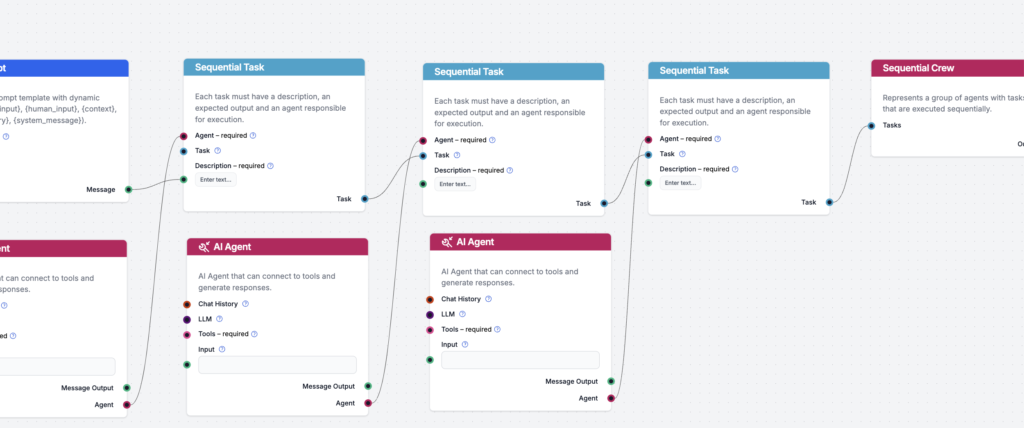Crew.ai vs Langchain: A Thorough Look at Multi-Agent Frameworks
A deep dive into Crew.ai and Langchain, comparing their strengths in multi-agent collaboration and NLP to help you choose the right framework for your AI projects.

When you’re diving into AI development projects, picking the right multi-agent framework is key to getting the results you want. This blog takes a close look at two popular frameworks: Crew.ai and Langchain. Each has its own special features and strengths, but knowing what each can do will help you use them to their fullest. Flowhunt supports both approaches and once you are designing new AI workflows, you should choose carefully what is the best choice for your task.
Getting to Know Crew.ai
Crew.ai is all about making it easy for AI agents to work together. Its main aim is to let agents collaborate effectively, mimicking how humans work in teams. A big plus for Crew.ai is its multi-agent collaboration and role-playing abilities, which let agents split up tasks based on what they’re best at. This framework really shines in projects needing a lot of interaction and coordination among agents. For instance, in complex simulations where agents have to adjust to changing environments, Crew.ai is great at promoting real-time communication between agents. Crew of agents decides alone when to use specific agent or tool based on the task given by the user.

Getting to Know Langchain
Langchain is a framework geared towards Natural Language Processing bridges human-computer interaction. Discover its key aspects, workings, and applications today!") (NLP) tasks. It’s well-known for focusing on language-based applications and has an easy-to-use interface that makes implementing NLP solutions simpler. Langchain’s pre-trained models are a big advantage, giving users strong tools for tasks like text generation and their diverse applications in AI, content creation, and automation."), translation, and summarization. It’s perfect for simple RAG chatbots, linear content creation flows, and any app where understanding language is crucial. Its simple setup is a plus for developers who want to roll out NLP applications quickly and efficiently.

In-Depth Comparison: Crew.ai vs Langchain
When you compare Crew.ai and Langchain, a few things stand out. First, Crew.ai excels in collaboration and multi-agent capabilities. Its framework is built for situations where multiple agents need to work together on complex tasks. On the other hand, Langchain’s strength is in NLP bridges human-computer interaction. Discover its key aspects, workings, and applications today!"), offering solid tools for processing language, generating stable results even if you call the same chain thousands times.
When to Choose Crew of Agents
AI crews of multiple agents, often referred to as multi-agent systems, can significantly enhance the quality of generated texts through several mechanisms:
Collaboration and Specialization
Multiple agents can be specialized in different aspects of text generation, such as grammar, style, content relevance, and creativity. By collaborating, each agent can contribute its expertise, resulting in a more polished and coherent output. Multi-agent systems are composed of multiple interacting intelligent agents that can solve problems difficult for an individual agent, enhancing the system’s capabilities through collaboration. SourceError Correction and Redundancy
With multiple agents working in parallel, the system can implement redundancy checks where one agent reviews the output of another. This setup helps in identifying and correcting errors more effectively, leading to higher quality text. Quantum error correction, for example, uses redundancy to protect information, although classical error correction often employs similar redundancy techniques. SourceDiverse Perspectives
Different agents can be designed to simulate varying perspectives or writing styles. This diversity allows for a richer set of possibilities and can lead to more nuanced and engaging text. AI models, like text-to-image models, often draw on diverse datasets to produce varied outputs, illustrating how diversity in input can enhance the diversity of output. SourceLearning and Adaptation
Multi-agent systems can engage in continual learning, where agents learn from each other’s outputs and user feedback to adapt and improve over time. This iterative process helps in refining the quality of generated texts. Multi-agent reinforcement learning involves agents learning in a shared environment, which can lead to improved strategies and outcomes through adaptation. SourceTask Distribution and Efficiency
By distributing different text generation tasks among various agents, the system can operate more efficiently, handling complex tasks in a shorter amount of time and improving the overall text quality through focused processing. Multi-agent systems enhance efficiency by distributing tasks among agents, thus solving complex problems more effectively. SourceFeedback Integration
Multi-agent systems can integrate feedback loops where one agent generates text and another evaluates it against predefined criteria, providing feedback for improvement before the text is finalized. Feedback loops are crucial in AI systems to refine outputs and enhance performance through continual evaluation and adjustment. Source
By leveraging these mechanisms, multi-agent AI systems can produce texts that are not only higher in quality but also more aligned with user expectations and requirements.
Frequently asked questions
- What is Crew.ai best suited for?
Crew.ai is designed for multi-agent collaboration, making it ideal for projects that require agents to work together and coordinate in real time, such as complex simulations and workflows involving task division.
- When should I choose Langchain over Crew.ai?
Langchain is preferable for Natural Language Processing (NLP) tasks like text generation, translation, and summarization. Its pre-trained models and simple setup make it ideal for rapid deployment of language-based AI applications.
- How do multi-agent systems improve text generation quality?
Multi-agent systems enhance text quality through collaboration, specialization, error correction, diverse perspectives, continual learning, efficient task distribution, and feedback integration, resulting in more coherent and refined outputs.
Viktor Zeman is a co-owner of QualityUnit. Even after 20 years of leading the company, he remains primarily a software engineer, specializing in AI, programmatic SEO, and backend development. He has contributed to numerous projects, including LiveAgent, PostAffiliatePro, FlowHunt, UrlsLab, and many others.

Ready to build your own AI?
Smart Chatbots and AI tools under one roof. Connect intuitive blocks to turn your ideas into automated Flows.


